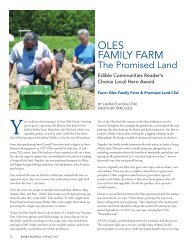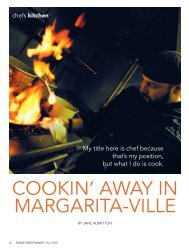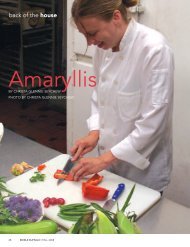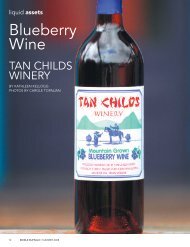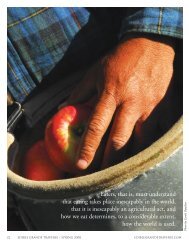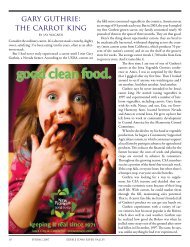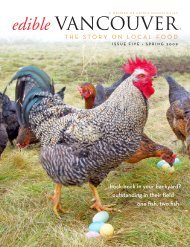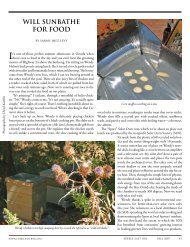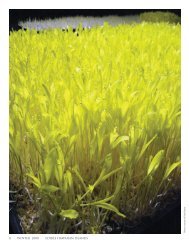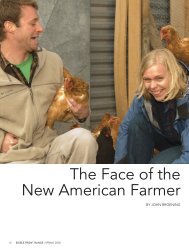liquid assets - Edible Communities
liquid assets - Edible Communities
liquid assets - Edible Communities
Create successful ePaper yourself
Turn your PDF publications into a flip-book with our unique Google optimized e-Paper software.
<strong>liquid</strong> <strong>assets</strong><br />
SPIRITS<br />
OF THE WEST<br />
BY CAROL O’MEARA<br />
58 EDIBLE FRONT RANGE | WINTER 2009
The beauty of craft distilling is that it brings back<br />
the snowflake individuality of what we do,<br />
where each batch has its own personality.<br />
Baby, it’s cold outside. After hitting the slopes or snowshoeing<br />
a quiet trail, you’re ready for the slow, mellow warmth that<br />
comes from lifting spirits.<br />
“Pour a wee dram and sit by the fire with a book,” says Jake Norris,<br />
head distiller for Stranahan’s Colorado Whiskey in Denver. “It’ll<br />
warm up all of your senses.”<br />
While reading this magazine is not exactly opening a novel, getting<br />
to know two of our first distillers in Colorado is a tale of two locations,<br />
but one passion: the finest crafted spirits in the state.<br />
Stranahan’s in the City<br />
Standing in the barrel-filled rack room of the distillery at 2405 Blake<br />
St., Norris was thoughtful about having just laid down his 900th<br />
barrel of the amber <strong>liquid</strong>. “These 900, they’re five years of my life,”<br />
he said, “Jim Beam makes 1,000 in three hours. But we’re not trying<br />
to make the most, just the best.”<br />
Norris and co-founder Jess Graber laid their first barrel of whiskey in<br />
January 2004, waiting two years until it matured. Graber, then a volunteer<br />
firefighter and construction worker in Woody Creek, had tinkered<br />
with distilling whiskey. A chance meeting with George<br />
Stranahan after a barn fire, then a link-up with Norris, a local bartender<br />
and whiskey expert, and the dream of turning a hobby into<br />
the first craft distillery in the state came to be.<br />
Stranahan’s produces a unique Colorado-style whiskey, unlike scotch<br />
or bourbon. Starting with 100 percent malted barley; the grain is fermented<br />
by Oskar Blues brewery in Lyons with yeast selected for<br />
quality and character. They shun the faster-producing genetically<br />
modified yeasts some microdistillers use.<br />
Each week, the <strong>liquid</strong> from fermentation is put batch by batch into<br />
the unique 750-gallon copper pot-and-column still. Custom-made<br />
by Vendome Stillworks in Louisville, Kentucky, the still combines<br />
processes from scotch, made in a pot-style still, with the column-type<br />
distilling of bourbon. Convincing the oldest, greatest still maker in<br />
Stranahan’s co-founder Jess Graber. Photo by Ben Tremper<br />
the United States to build for a small distillery was a coup, “like<br />
getting Ferrari to build a go-kart,” Norris said.<br />
Once distilled, the clear, sweet new spirit is merged with a little purified<br />
water, then poured into American oak barrels, where it ages,<br />
taking on amber color and caramel notes from the wood. They lay six<br />
barrels every five days, and for optimum flavor, they’re kept at 65°.<br />
“In here, we create the perfect summer’s day,” says Norris, who<br />
prefers his summers cool, “that’s critical to getting the big whiskey<br />
flavor we’re known for.”<br />
The final step comes with hand selection of 10 to 12 barrels to make<br />
the small batch, approximately 2,500 bottles. Tasting from barrels<br />
young, old and in-between, the team of four distillers pulls together a<br />
blend that is at once classically Stranahan’s, but individually unique.<br />
“To create a whiskey of complexity, we have a person in touch every<br />
step of the way. Each batch has nuances, subtleties all its own,” he<br />
said. “I don’t believe in consistency of flavor, where every bottle tastes<br />
exactly the same. The beauty of craft distilling is that it brings back<br />
the snowflake individuality of what we do, where each batch has its<br />
own personality.”<br />
“There’s no wrong way to drink whiskey,” says Norris, nonetheless<br />
offering suggestions on finding the right way to drink your<br />
Stranahan’s:<br />
• Serve at cellar temperature, neat, with no water or ice.<br />
• Nose the whiskey first by placing the rim of the glass on the<br />
skin between your nose and lip. Part your lips slightly and<br />
inhale with both nose and mouth.<br />
• Take your first sip as you would a hot cup of coffee, drawing air<br />
along with <strong>liquid</strong>.<br />
• Though the first sip overwhelms your palate, it quickly gets acclimated.<br />
In the second and third sips, you’ll taste the finer<br />
flavors.<br />
• Add a small dollop of water, then taste again.<br />
• Add two small dashes of water, taste again.<br />
• Drop in a few ice cubes to chill the whiskey. The colder it gets,<br />
the more some characteristics are suppressed, leaving a<br />
sweeter, smoother taste.<br />
EDIBLE FRONT RANGE | WINTER 2009 59
Peak Spirits in the Country<br />
“If we couldn’t farm we wouldn’t be doing this,” says Lance Hanson,<br />
who with his wife, Anne, founded Peak Spirits in Hotchkiss. “It’s the<br />
lifestyle and where we spend time—that’s the important thing.” A<br />
love of the land he works has led Hanson to become certified in biodynamic<br />
farming by Demeter USA, part of a nonprofit group<br />
founded in Europe in 1928 to promote the agricultural methods of<br />
Dr. Rudolf Steiner, father of the biodynamic movement. Viewing<br />
farms as living organisms, Steiner believed that by healthful, natural<br />
management, farms could be self-sustaining.<br />
Shutting off his tractor after giving his vineyard a late-season<br />
nightcap of compost and herbal tea, Hanson explained this type of<br />
farming.<br />
“Biodynamic practices are a holistic approach; it’s a superset of organic<br />
methods, taken further by using your natural resource <strong>assets</strong> to<br />
farm better.”<br />
That means Welsh mountain sheep placidly graze the 22-acre<br />
vineyard to keep weeds low and add rich manure. The margins along<br />
their land are left as refuge for wildlife, including pheasants, chukkar,<br />
partridges, and insects.<br />
“Rather than wiping everything out, we foster all on our property.<br />
That’s nature’s way of keeping things in check,” he said.<br />
Tasting the difference biodynamic farming gives to his products is<br />
subjective, Hanson notes, but healthier vines produce sweeter, richer<br />
fruit that sets their spirits apart from others.<br />
Hanson, Anne and their two children, Evan and Hatley, moved to<br />
western Colorado in 2000 from California, giving up a life in<br />
software and teaching to run a vineyard. Producing vodka, gin,<br />
grappa and Eau de Vie, a brandy, in addition to their wines was a decision<br />
that came from looking at how a farm could be sustainable<br />
beyond a single crop.<br />
In 2005 they fired up their still, bottling Eau de Vie, expanding every<br />
year to their current production of vodka, gin, grappa, and wine.<br />
Peak Spirits showcases quality, local fruit grown in the nearby orchards<br />
of the North Valley. Their Eau de Vie is redolent of peaches,<br />
apples or pears, and though it’s drier than mainstream brandies, the<br />
essence of the fruit blooms in your mouth.<br />
“It takes a lot of fruit to produce a split [350 ml]—about 25 to 30<br />
pounds per bottle. That much is expensive, but it’s the best way to do<br />
it. We could stretch the fruit with water and sugar but the brandy<br />
wouldn’t be as expressive in taste, which is what this is all about.”<br />
For the Hansons, the beauty of their industry is exploration, trying<br />
new ways to distill perfection. Their adventurous spirit can be tasted<br />
in the anise, lavender and rose petals infusing their CapRock Gin, a<br />
dry elixir with an apple base. Or treat yourself to CapRock Vodka,<br />
distilled from grapes instead of potatoes or grains. The silky, crystal<br />
clear <strong>liquid</strong> is complex and fruity, perfect for enjoying with friends.<br />
Enjoy your spirits with Hanson’s tips:<br />
• Eau de Vie, “water of life” in French, is assertive and intense.<br />
Many are not prepared for the unique flavors of this dry<br />
brandy. The intense aromatics bring you right to the orchard<br />
floor, where you smell everything: the skins, seeds and pulp.<br />
Perfect for after dinner as a digestive; savor it by itself, but if<br />
you find it too strong, counter it with coffee.<br />
• Freezing is not for finer vodkas or gin, as the chill dampens nuances<br />
and flavors. “The mark of any good spirit is that you can<br />
enjoy it at cellar temperature [55° to 65°],” says Hanson. Serve<br />
it neat, on the rocks or in an elegant martini.<br />
Carol O’Meara, a freelance writer who loves all things botanically<br />
based, can be reached at omearac@yahoo.com.<br />
“This is an undocumented art; there’re no textbooks on craft distilling,”<br />
he said. Learning was elusive, but luckily, the national community<br />
of distillers is a friendly one, and the Hansons found many<br />
who shared advice.<br />
Lance Hanson, co-founder of Peak Spirits.<br />
Photo by Michael Brands, courtesy of edibleASPEN magazine<br />
If we couldn’t farm we wouldn’t be doing this<br />
...It’s the lifestyle and where we spend time<br />
—that’s the important thing<br />
60 EDIBLE FRONT RANGE | WINTER 2009
EDIBLE FRONT RANGE | WINTER 2009 61



